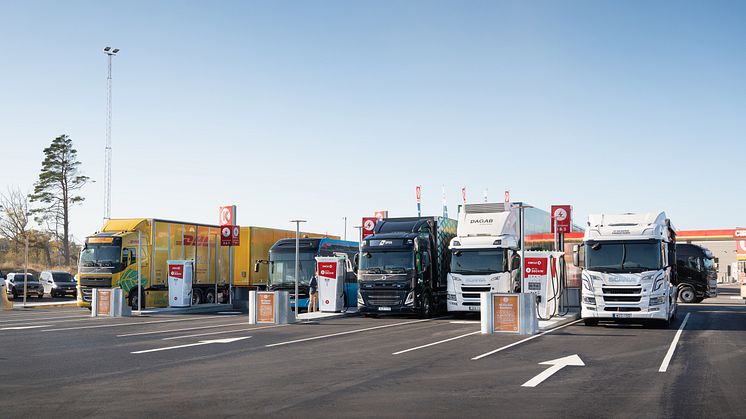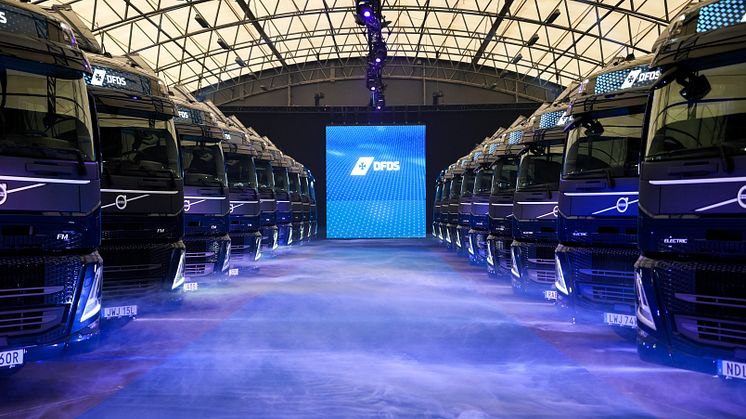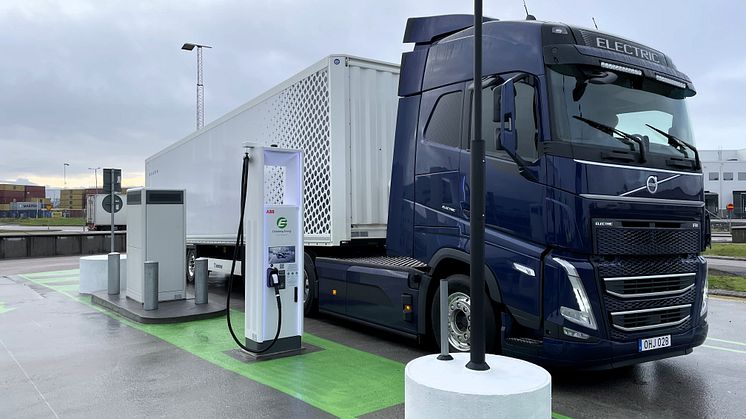
Press release -
The first public charging and hydrogen filling station in the Nordic region for heavy goods traffic opened at the Port of Gothenburg
The gates are now open for Circle K’s charging and hydrogen filling station in the Port of Gothenburg. The station is the first of its kind in the Nordic region and has been built from a heavy trucks perspective, with the intention of facilitating the green transition for heavy goods traffic in and around the Port of Gothenburg.
The station will form a new hub of the port for facilitating the transition from fossil to electricity and alternative fuels for heavy goods traffic. Initially there will be six public charging stations for electrically powered heavy trucks, with a capacity of up to 360 kW per charging bay. Having several charging bays at the same location means not only increased capacity, but also shorter waiting times. Within one year there will be hydrogen available at the station, a real fuel of the future that only emits heat and water.
Over one million heavy trucks collect or deliver goods at the Port of Gothenburg every year. The port has conducted a study of the driving patterns of the heavy trucks together with Volvo Group, Scania and Stena Line in the collaboration initiative Tranzero. A large proportion of heavy trucks have been identified as particularly suitable for the fossil-free transition here and now, and a public station for charging and hydrogen in the heart of the port will be a key enabler.
“The station’s opening at exactly the right place, in terms of both timing and location. Serial production of electric heavy goods vehicles is up and running, and vehicles have been ordered by actors with a lot of traffic at the port. By the end of the year, electric heavy trucks will be a common sight in the port, and it will just keep on growing from there. So, this station comes at just the right time – the transition is taking place here and now, and as far as the port is concerned we’re delighted to be able to work with Circle K to provide the necessary infrastructure,” says Elvir Dzanic, CEO at the Gothenburg Port Authority.
In addition to fossil-free fuels, the station is a full-service station offering everything users need while their vehicle is charging, such as a wide range of food and drinks, and of course showers and toilets. Also available is security parking within a fenced area, with CCTV surveillance and room for about 40 heavy trucks. This is a place where drivers who need to can rest for an hour or so, or even overnight, and do so safely – something there is tremendous demand for.
“The station is a magnificent flagship and a real milestone along the way to a future of greener transport operations. We’re incredibly happy and proud to be leading the way on this journey and of what we’ve achieved, such as the collaboration with the port. The station’s strategic location and smart structure mean that we’re well-prepared for the market’s future needs for different fuels. This station has the potential to become an important hub in the transition,” says Lennart Olsson, the person responsible for heavy goods traffic charging at Circle K.
The station is built from a heavy trucks perspective, providing good turning radius and ensuring that all charging bays can be accessed from multiple directions by different kinds of heavy trucks.
In a nutshell: The first public charging and hydrogen filling station in the Nordic region for heavy goods traffic
Charging bays for heavy goods traffic: 6 (with possibility for more bays)
Charging power: 360 kW (1 MW possible if more bays)
The station’s network capacity: 6 MW (with possibility of an additional 6 MW soon)
Hydrogen available for heavy goods traffic: In one year’s time
Hydrogen bays for heavy goods traffic: 1 (when fully expanded)
Hydrogen capacity: 720 kg, approx. 15 heavy trucks/day (when fully expanded)
Topics
Fact file: Port of Gothenburg
The Port of Gothenburg is the largest port in Scandinavia. Around 30% of Swedish domestic and foreign trade passes through the Port of Gothenburg and over 50% of all container traffic. The port is a full-service port, and offers industry guaranteed, climate-smart access to the whole world. Direct services to key markets ensure highly efficient, sustainable, and reliable transport 24 hours a day, 365 days a year. The focus is firmly on sustainability, innovation, and digitalisation in a concerted effort to maintain the ongoing development of climate-efficient freight transport and calls by vessels. With over 30 rail shuttles offering daily departures, companies throughout Sweden and Norway have a direct, climate-neutral service to the Port of Gothenburg. The port handles energy products, vehicles, ro-ro units, containers and passengers. 22,000 people are employed at the port.
Follow us on:
Facebook
Instagram
LinkedIn
Twitter
www.portofgothenburg.com




